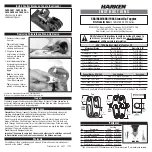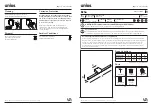
1 689 989 210
2015-10-20
|
Robert Bosch GmbH
30 | Diesel Set 3.1 | Testing
en
4.
Using the appropriate connection adapter, angle, nut
and compression ring (left-hand thread), connect the
second 180 MPa hose assembly (fig. 16, item 1) to
the injector and pressure sensor (fig. 16, item 5).
5.
Tighten all threaded connections. When tightening,
use a second hex key to keep the hose fitting on the
pressure module and injector from turning.
6.
Attach the connecting cable to the digital pressure
display unit (fig. 16, item 3) and rail pressure sensor
of the pressure module (fig. 16, item 5).
7.
Press the power key on the digital pressure display
for about 1 second.
4.2.2
Connecting the pressure sensor
(engine running with all cylinders)
i
Extension set 0 986 613 925 is required.
Abb. 16: Example of connecting the rail pressure sensor for a
comparison test (engine running with all cylinders)
1 180 MPa hose assembly attached to injector high-pressure con-
nection
2 180 MPa hose assembly attached to rail connection
3 Digital pressure display unit
4 Pressure limiter test oil return connection (180 MPa)
5 Pressure sensor with rail pressure sensor, pressure limiter
1.
Clean the rail and injectors completely with com-
mercially available cold cleaner and blow dry with
compressed air.
2.
At a readily accessible injector, disconnect the high-
pressure hose assembly from the injector and rail.
!
Ensure that no test oil spills onto the radiator hoses
and drive belt during installation. The radiator hoses
and drive belt are not resistant to the test oil.
!
For safety reasons, a pressure limiter that limits the
pressure to 180 MPa is incorporated into the pres-
sure sensor (fig. 16, item 5). Be sure to attach the
provided hose to the connection (fig. 16, item 4) on
the pressure sensor and direct it into a collecting
container suitable for diesel fuel.
3.
Using the appropriate connection adapter, angle, nut
and compression ring (left-hand thread), connect the
first 180 MPa hose assembly (fig. 16, item 2) to the
rail and pressure sensor (fig. 16, item 5).
















































